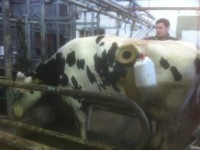We have all been told that the Rumen is vital to a healthy productive animal so here is a quick run down on some interesting points about the Rumen.
The rumen allows the animals to get the majority of their nutrients from forages and other Roughages. Non ruminant animals like ourselves cannot obtain any real nutritional value from most plant sources unless the food has been modified, ground mashed etc.
A ruminant animal has 4 stomachs, the Reticulum, the Rumen, the Omasum and the Abomasum.
The Rumen is the largest part of the digestive system measuring up to 50 gallons and situated on the left hand side of the abdomen.
It is essentially a large fermentation vat where forages are stored, mixed and broken down further by billions of microbes in the Rumen. These microbes help to break down the forage into manageable substances that can be absorbed through the wall of the Rumen and also by creating microbial protein from the forages.
These microbes are vital to getting the most from the food sources and it is vitally important that the rumen ph is kept stable and around the level PH 6. If the PH drops to a more acidic environment due to incorrect nutrition these microbes shut down and die and the food in the Rumen does not get broken down quickly. Thus the animal is full and cannot absorb enough nutrients to produce milk or beef at the levels we need.
When we are formulation our feeds we must keep in mind that our feeds need to:
- Keep the Microbes and bugs in the Rumen alive by maintaining a stable PH by using the correct type and amount of cereals such as Wheat, Barley and Maize. These are great feed ingredients which we can get volumes of them into an animal by balancing the formulations correctly. Too much of these in the incorrect order or poor feeding management can cause a drop in PH and acidosis can occur.
- We must feed the microbes in the Rumen by providing them with nutrients to allow them to multiply, and carry out their job of converting forages into nutrients that the animal can absorb in the Rumen. Essentially we need to provide them with fuel to do the job for us.
- We must also balance the proteins and more importantly the types of proteins in our feeds to ensure that we do not create excess Nitrogen levels in the animal which is toxic to it and which leads to the animal wasting its own energy converting this excess nitrogen into urine and other associated by-products. This process can be extremely wasteful in terms of lost potential energy that the animal could be using to grow or produce milk.
- We also formulate our feeds to provide correct levels of bypass protein. These bypass proteins do not get broken down in the rumen. Rather it is absorbed farther on the digestive system in the small intestine. We do this so that when an animal eats its feed that it is not all broken down in an hour or two spent in the rumen and abomasum. We want some of that protein to travel to the small intestine where it can be readily absorbed into the animal’s bloodstream very efficiently. Thus it spreads out the work for the animal to absorb these nutrients throughout the day.
So in short the Rumen is vital to a productive animal and maintaining the rumen at a stable PH and not making big changes to the diet can have huge benefits to the productivity and efficiency of the animal.
Using the latest research findings and our years of experience in Animal Nutrition we formulate all our feeds more maximum Rumen nutrient absorbtion Efficiency. Hence our range of high energy feeds have performed so well over this winter even with poor fodder quality in many farms.
Contact us for more information on our range of balanced high efficiency feeds.

